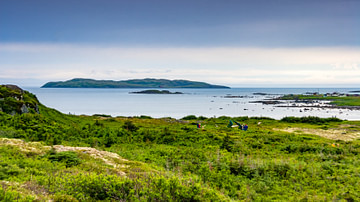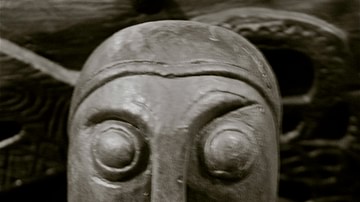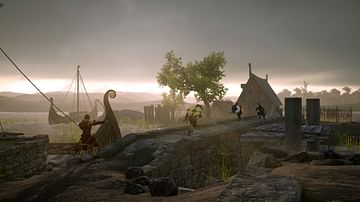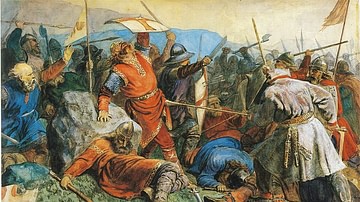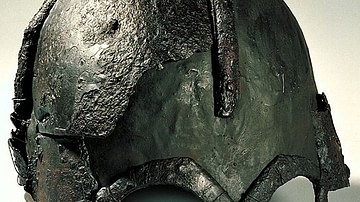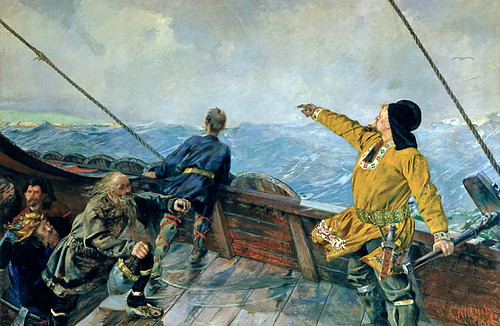
Leif Erikson (also spelled Leif Eriksson, Old Norse Leifr Eiríksson), nicknamed Leif 'the Lucky', was a Norse Viking who is best known for arguably being the first European to have set foot on North American soil along with his crew c. 1000 CE. Probably born in Iceland around 970-980 CE, Leif was the son of the famous Erik the Red who set up the first Viking settlement in Greenland in the late 980s CE. After his father's death just after 1000 CE, Leif succeeded him as chieftain of Greenland, and because his son Thorkel had succeeded him by 1025 CE it is fair to assume Leif had died by then, though it is unsure exactly when.
Leif's larger-than-life reputation mostly stems from the 13th-century CE Icelandic Vinland Sagas (the independently composed The Saga of the Greenlanders and Erik the Red's Saga) which tell the story of how he kitted out the first Norse expedition to Newfoundland and the surrounding areas, in present-day Canada. Here, he discovered, among others, the grapevines that inspired the Vikings' name for the area: Vinland (Old Norse Vínland, 'Wine Land'). In fact, most of what we know about Leif Erikson comes from these two sagas. Importantly, they were not eye-witness accounts but concern events dating to more than two centuries before they were written down. The stories' similarities and their context, however, do support the idea that they refer to real people and events that were at least partially preserved by means of an oral tradition. The archaeological record offers some help, too: the remains of the Norse settlement credited by the sagas as being founded by Leif have indeed been found in Newfoundland, at L'Anse aux Meadows.
Early Life
Although we know little of Leif's childhood and early years, we do know his family certainly had a knack for making life interesting. Leif's ancestry lies in Jæren, Norway, where his grandfather Thorvald, son of Asvald Ulfsson, got into such a degree of trouble by killing someone that he packed up his family and fled to Iceland, where the Norse had been present since the last quarter of the 9th century CE. There, Thorvald died, leaving his son Erik to carve out a life for himself. In Iceland, Erik, who would 'officially' have been Erik Thorvaldsson but is better known as Erik the Red (probably giving a none too subtle hint about his hair- and beard colour) married local girl Thjodhild, the daughter of Jorund Atlason, whose family had Irish blood somewhere down the line. This Irish connection was a not uncommon by-product of the Viking's exploits in the British Isles starting in the late 9th century CE. Erik and Thjodhild seem to have settled down and built a farm they called Eiríksstaðir near Vatnshorn on the Breidafjord, in the west of Iceland, which is probably where Leif was born. Leif had two brothers, Thorstein and Thorvald, as well as a sister, Freydis, who according to Erik the Red's Saga was an illegitimate daughter of Erik's.
A quiet life was not in the cards for Leif's family; his father Erik followed in grandfather Thorvald's footsteps in being exiled for murder, too, around 982 CE. This time, however, there was no known Norse settlement to the west that they could easily move to. Following rumours of land that had been sighted west of Iceland, though, Erik the Red sailed there and allegedly became the first Viking to set foot on Greenland, coining the name to entice more people to come and settle there. He founded what would become the Eastern Settlement on Greenland's southern tip around 985 CE, picking the choicest morsel of land for himself and his family and setting up a farm called Brattahlíð in the confidently named Eriksfjord. Young Leif thus grew up there within a pioneering lifestyle, while around him Greenland was further explored and settled. The people surrounding him in this initial colonisation of Greenland would have come from Iceland and were mostly chieftains and rich farmers who owned their own ships, probably counting around 500 individuals; they set up stock farms with the domestic animals they had brought along in their ships in the inner fjords where land was comparatively fertile.
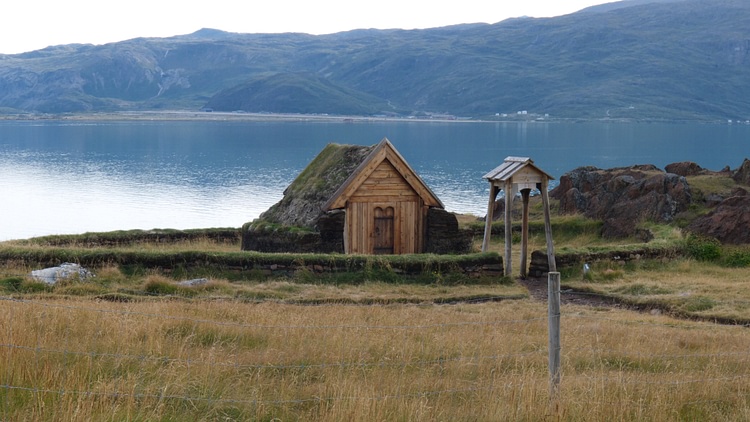
Leif in the Hebrides & Norway
Leif's exploits prior to his famous American venture are laid out in a sole source, Erik the Red's Saga, whose accuracy is thus tricky to verify. The saga relays how Leif, who is described as a promising young man, wants to sail from Greenland to Norway one summer but is blown off-course to the Hebrides, where the suboptimal sailing conditions keep him stranded there all summer. There, he makes use of a previously established Norse foothold on the islands. Luckily for Leif, his holiday is anything but boring: he meets a lady of high birth named Thorgunna, whom he falls in love with to such a degree she states she is pregnant by the time Leif is ready to set sail again. Although Thorgunna wishes to go home with Leif, her family's approval has not been sought and according to the saga, Leif feels 'reluctant to abduct a woman of such high birth from a foreign country.' (Erik the Red's Saga 5, in Smiley, 660). She is not happy with this and informs Leif she will send her child over to him in Greenland as soon as he is old enough to travel. Thorgunna later gives birth to a son, Thorgils, who eventually does come to Greenland and is recognised by Leif as his son, or so the saga says.
Leif then continues the journey to his original destination, Norway, where he swears loyalty to Olaf Tryggvason, the King of Norway (r. 995-1000 CE), the man who went down in history among others for playing a part in the spread of Christianity among the Norse. Erik's Saga clearly carries out this theme too, and, again being the only source for this otherwise unknown attribution, states that King Olaf asks Leif Erikson to become his envoy and convert Greenland to Christianity. Leif agrees to this. Historically, it is possible (or even probable) that the Norse Greenlanders were already Christian around the time of the initial settlement, however. Iceland officially adopted Christianity in 1000 CE - with Greenland following soon after, prior to which the religion had already begun to take decent root. Olaf Tryggvason's role in its spread seems a tad exaggerated, anyway: although he is credited by the sagas as converting the people of Shetland and Orkney, for instance, the archaeological record demonstrates they had already adopted Christianity well before the end of the 10th century CE. Similarly, Leif's role in the Christianisation of Greenland should not go unquestioned, either, as Gísli Sigurðsson explains:
The people who left Breidafjord in Iceland with Eiríkr the Red in 985 or 986 and settled in Greenland have not left behind any signs of heathen burial customs in Greenland. The oldest graves from the cemetery of Þjóðhild's [Thjodhild, Leif's mother] church are Christian and date from the end of the tenth century. This shows that Christianity was the living religion of these people, even though Óláfr Tryggvason is supposed to have sent Leifr Eiríksson the Lucky to convert them in 1000. (Brink & Price, 564).
Erik the Red's Saga claims that Leif's father Erik refused to convert, although his mother did, and that 'after her conversion, Thjodhild refused to sleep with Eirik, much to his displeasure.' (Erik the Red's Saga 5 in Smiley, 661).

Vinland: Journeys to America
Continuing the story from Erik the Red's Saga, before Leif even gets back to Greenland from Norway to start his preaching gig, he once again ends up on a side-quest:
After being tossed about at sea for a long time he chanced upon land where he had not expected any to be found. Fields of self-sown wheat and vines were growing there; also, there were trees known as maple, and they took specimens of all of them. Leif also chanced upon men clinging to a ship's wreck, whom he brought home and found shelter for over the winter. In so doing he showed his strong character and kindness. (…) Afterwards he became known as Leif the Lucky. (Erik the Red's Saga 5, quoted from Smiley, 661).
This is the crux of Leif Erikson's fame: the European discovery of the lands the Norse called Vínland ('Wine Land'), on the eastern shores of North America - a landmass which was of course already inhabited. Vinland is thought to have encompassed the whole area from the Strait of Belle Isle in Newfoundland to the Gulf of St Lawrence and its southern shores, perhaps stretching to Prince Edward Island and New Brunswick. Here, The Saga of the Greenlanders chips in with additional (and sometimes divergent) information. This saga instead attributes the first sighting of (if not landing on) Vinland to Bjarni Herjólfsson, who here is the one who was blown off-course. Leif then hears of his land-sighting story back in Greenland, launches an expedition, and first reaches a glacier-covered stone slab of land he and his crew name Helluland ('Stone-slab Land', likely northern Labrador and/or Baffin Island) and then a flat and forested land they call Markland ('Forest Land', likely central Labrador). Eventually they come upon a lush land where they found a base they name Leifsbúðir ('Leif's Booths'). It is while exploring the surrounding lands, especially further south, that Leif and his men discover timber and the grapes that inspire Vinland's name.
In Erik the Red's Saga, the base set up by Leif is instead named Straumfjǫrðr ('Fjord of Currents'). Its different name might be explained by the fact that this saga seems to downplay Leif's role in general, focusing instead on his sister-in-law Gudrid and her husband Karlsefni who are depicted as leading one big expedition to Vinland. This is a possible result of a movement in the 13th century CE which sought to canonise Bishop Björn Gilsson, a direct descendant of theirs. Either way, Leifsbúðir/Straumfjǫrðr, or whatever it may have been called, became the biggest archaeological boost to Leif's Vinland story in 1961 CE, when the remains of a Norse settlement were discovered at L'Anse aux Meadows on the northernmost tip of Newfoundland's Northern Peninsula, in present-day Canada. Eight turf-walled dwellings, including what looks like chieftains' halls, other large halls, smaller halls and huts, all with large storage spaces and some with workshops built in, were uncovered and date to between 980-1020 CE. They thus fit the sagas' timeframes. A ringed pin of the Dublin Viking type was found there, too, tying in with information from the sagas about the Viking explorers having had family connections in Ireland (such as Leif's mother having Irish ancestry).
The settlement, which could have housed between 70-90 people, was set up for work crews who probably used the site as a gateway location, overwintering there and then launching expeditions to other regions where they gathered timber, grapes, furs, and other valuable resources. These could then be stored at L'Anse aux Meadows until they could be ferried back to Greenland. It was in use for perhaps less than a decade, before a combination of the too-extravagant distance from there to Greenland and competition with natives gave the venture the 'not worth the hassle' stamp.
L'Anse aux Meadows was clearly the Viking's main base in North America - based on the fact that the Norse population in Greenland around 1000 CE would have been too small to support another large settlement in America - and there is no doubt that it corresponds with the Straumfjǫrðr and Leifsbúðir from the sagas. Leif is actually a good candidate for the historical leader of at least one of the expeditions to Vinland, as the buildings found at L'Anse aux Meadows indicate the presence of an important chieftain. Leif fits this description: with his father Erik the Red being the head honcho of Norse Greenland around the start of the Vinland journeys, it is likely Erik would have initially overseen or authorised these journeys and that Leif would have functioned as his deputy in actually carrying them out. It is not too much of a stretch to believe Leif's Vinland adventures as depicted in the sagas are at least partially rooted in historical reality.
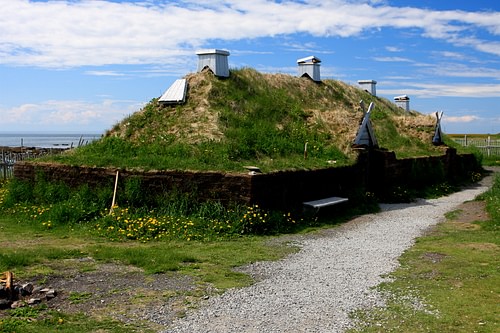
The Post-Vinland Years
Erik the Red died sometime in the years just after 1000 CE. Leif succeeded him, becoming chief of Greenland and returning there to sort stuff out there while passing on the Vinland baton to his deputies – all family and extended family, if we follow the sagas. They would have been required to bring Leif a share of their riches, further adding to what was probably already a comfortable lifestyle for him. Leif's brother Thorvald is described in The Saga of the Greenlanders as leading an expedition to Vinland and borrowing both Leif's ship and his houses at Leifsbúðir for it. He explores the surrounding area with his crew but is used as a pin-cushion by arrows fired from natives, and dies, far away from home. Another brother, Thorstein then comes to Vinland, too, to recover his brother's body. Leif also grants his sister-in-law Gudrid and her husband Karlsefni permission to use his houses in Vinland. The same goes for Leif's sister Freydis, who in a somewhat strange story spreads weird rumours and gets her crew to fight amongst themselves, resulting in deaths, with Freydis killing off the remaining women with her own hands. The saga describes how the party returns to Greenland, Leif eventually finds out what happened, and condemns her but does not take any further action against her.
The only other theme the sagas focus on in Leif's post-Vinland years is his alleged role in spreading Christianity across Greenland – one we have already labelled as dubious or at the very least hard to verify. His mother seems to have sponsored or given her name to a church, Thjodhild's church, built around the end of the 10th century CE, though. Leif is last mentioned alive in written records in 1019 CE, and we know that his son Thorkel became chieftain of Greenland in 1025 CE. Presumably, then, Leif died sometime between 1019 and 1025 CE. Other than his summer of love in the Hebrides with Thorgunna, no other partner is mentioned for him, so we do not know how this Thorkel came into the world.
Legacy
By the 19th century CE, before the discovery of L'Anse aux Meadows lifted the Vinland Sagas' stories from the pages of books into archaeological reality, Leif Erikson was the chosen hero of many of the Scandinavians who emigrated to North America around this time. In 1898 CE, a forged rune-stone known as the Kensington Stone popped up in Minnesota sporting an 'amateurishly concocted inscription supposedly made by fourteenth-century descendants of Viking settlers.' (Sawyer, 245). From the archaeological confirmation of a Norse presence in America in the 1960s CE, Christopher Columbus has had to share the stage with the Norse Viking Leif Erikson who beat him to the American punch by around 500 years, and who has been granted his own day in the United States, too: Leif Erikson Day, on October 9th.


